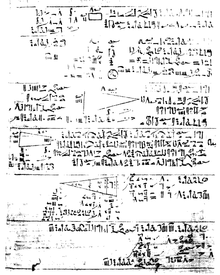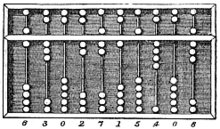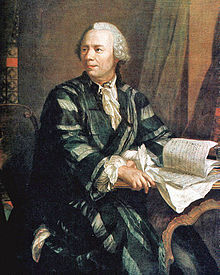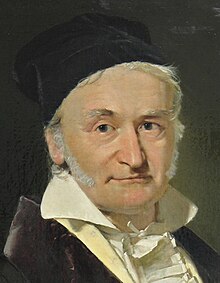Math
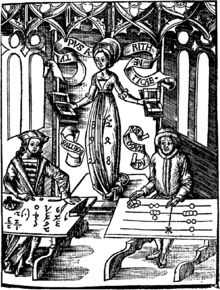
The mathematics (from the Latin mathematĭca, and this from the Greek μαθηματικά, transliterated as mathēmatiká, derived from μάθημα, tr. máthēma. 'knowledge') is a formal science that arose from the study of geometric figures and arithmetic with numbers. There is no generally accepted definition of mathematics; today they are often described as a science that uses logic to examine the properties and patterns of abstract structures created by logical definitions.
Description
The natural sciences have made extensive use of mathematics to explain various observable phenomena, as expressed by Eugene Paul Wigner (Nobel Prize Winner in Physics in 1963):
The enormous usefulness of mathematics in the natural sciences is something that prays the mysterious, and there is no explanation for it. It is not at all natural that there are "laws of nature", and much less that man is able to discover them. The miracle of how appropriate the language of mathematics results for the formulation of the laws of physics is a wonderful gift that we do not understand or deserve.
Galileo Galilei, along the same lines, had expressed it like this:
Philosophy is written in this great book, which is continually open before our eyes—I mean the universe—but it cannot be understood without first learning to understand the language and to know the characters in which it is written. It is written in mathematical language (...)
Through abstraction and the use of logic in reasoning, mathematics has evolved based on calculation and measurement, along with the systematic study of the shape and motion of physical objects. Mathematics, from its beginnings, has had a practical purpose.
Explanations based on logic first appeared with Hellenic mathematics, especially with Euclid's Elements. Mathematics continued to develop, with continual interruptions, until in the Renaissance mathematical innovations interacted with new scientific discoveries. As a consequence, there was an acceleration in research that continues to this day.
Today, mathematics is used around the world as an essential tool in many fields, including natural sciences, applied sciences, humanities, medicine, and social sciences, and even disciplines that, apparently, they are not linked to it, like music (for example, in matters of harmonic resonance). Applied mathematics, a branch of mathematics aimed at applying mathematical knowledge to other fields, inspires and makes use of new mathematical discoveries and sometimes leads to the development of new disciplines. Mathematicians also participate in pure mathematics, regardless of the application of this science, although practical applications of pure mathematics are often discovered over time.
History
Mathematics is one of the oldest sciences. It flourished first before antiquity in Mesopotamia, India, and China, and later in antiquity in Greece and Hellenism. Hence the orientation towards the task of "purely logical proof" and the first axiomatization, namely Euclidean geometry. In the Middle Ages it survived independently in the early humanism of the universities and in the Arab world.
In the early modern era, François Viète introduced variables and René Descartes inaugurated a computational approach to geometry using coordinates. The consideration of the rates of change (flux) as well as the description of the tangents and the determination of the contents of the surfaces ("squaring") led to the infinitesimal calculus of Gottfried Wilhelm Leibniz and Isaac Newton. Newton's mechanics and his law of gravitation were also a source of orientation for mathematical problems such as the three-body problem in the following centuries.
Another major problem in early modern times was solving increasingly complicated algebraic equations. To deal with this, Niels Henrik Abel and Évariste Galois developed the concept of a group, which describes the relationships between the symmetries of an object. The most recent algebra and, in particular, algebraic geometry can be considered as a deepening of these investigations.
A then new idea in the exchange of letters between Blaise Pascal and Pierre de Fermat in 1654 led to the solution of an old problem for which other, albeit controversial, solutions already existed. The exchange of letters is considered the birth of classical probability theory. New ideas and methods conquered many fields. But for centuries, classical probability theory split into separate schools. Attempts to explicitly define the term "probability" they were only successful for special cases. Only the publication of Andrei Kolmogorov's textbook in 1933 "The Foundations of Probability Theory" completed the development of the foundations of modern probability theory.
In the course of the 19th century, the infinitesimal calculus found its current form of rigor thanks to the work of Augustin- Louis Cauchy and Karl Weierstrass. The set theory developed by Georg Cantor towards the end of the XIX century is also indispensable in current mathematics, although the paradoxes of the concept Naive set of sets made clear, at first, the uncertain foundation on which mathematics was based.
The development of the first half of the XX century was influenced by David Hilbert's list of 23 mathematical problems. One of the problems was the attempt to fully axiomatize mathematics; At the same time, great efforts were made at abstraction, that is, the attempt to reduce objects to their essential properties. Thus Emmy Noether developed the foundations of modern algebra, Felix Hausdorff developed general topology as the study of topological spaces, Stefan Banach developed probably the most important concept in functional analysis, the Banach space that bears his name. An even higher level of abstraction, a common framework for considering similar constructions from different areas of mathematics, was finally created by the introduction of category theory by Samuel Eilenberg and Saunders Mac Lane.
Introduction
Etymology
The word «mathematics» (from the Greek μαθηματικά mathēmatiká, «things that are learned») comes from the ancient Greek μάθημα (máthēma), which means «field of study or instruction. Mathematics requires an instruction or learning effort, referring to areas of knowledge that can only be understood after having been instructed in them, such as astronomy. «The mathematical art» (μαθηματική τέχνη, mathēmatikḗ tékhnē) would be opposed in this to music, «the art of the muses» (μουσική τέχνη, mousikē téchnē ), which would be an art, like poetry, rhetoric and the like, that can be appreciated directly, "that can be understood without having been instructed". Although the term was already used by the Pythagoreans ( matematikoi) in the VI century BC. C., reached its more technical and reduced meaning of «mathematical study» in the time of Aristotle (IV century BCE)..). Its adjective is μαθηματικός (mathēmatikós), “related to learning”, which similarly came to mean “mathematical”. In particular, μαθηματική τέχνη (mathēmatikḗ tékhnē; in Latin ars mathematica), means "the mathematical art".
The most commonly used form is the plural mathematics (shortened to "mates"), which has the same meaning as the singular and comes from the Latin form mathematica (Cicero), based on the Greek plural τα μαθηματικά (ta mathēmatiká), used by Aristotle and which roughly means "all mathematical things". Some authors, however, make use of the singular form of the term; Such is the case of Bourbaki, in the treatise Elements of mathematics (Élements de mathématique, 1940), he highlights the uniformity of this field provided by the modern axiomatic vision, although it also makes use of the plural form as in Éléments d'histoire des mathématiques (Elements of the History of Mathematics) (1969), possibly suggesting that it is Bourbaki who finally realizes the unification of mathematics. Likewise, in the writing L'Architecture des mathématiques (1948) he raises the issue in the section "Mathematics, singular or plural" where he defends the conceptual uniqueness of mathematics. mathematics although it makes use of the plural form in said writing.
Some math definitions
Establishing clear and precise definitions is the foundation of mathematics, but defining it has been difficult, some definitions of famous thinkers are shown:
- Rene Descartes: (Cirilo Flórez Miguel, ed. Complete work. Library of Great Thinkers 2004) "Mathematic is the science of order and measure, of beautiful chains of reasoning, all simple and easy."
- David Hilbert: (Putnam, Hilary: On the infinite. Philosophy of Mathematics, p.187, 1998). "In a certain sense, mathematical analysis is a symphony of infinity. Math is the system of demonstrable formulas."
- Benjamin Peirce: (Nahin, Paul, The Story of i, p.68, 1998). "Mathematics is science that draws necessary conclusions."
- Bertrand Russell: (Mathematic Principia, 1913). "Maths possess not only the truth, but a certain supreme beauty. A cold and austere beauty, like a sculpture».
- Ibo Bonilla: (What is mathematical?, Academia.edu, 2014). "Math is to unravel the rhythms of the Universe." "Mathematics is the science of structuring a studied reality, it is the set of its elements, proportions, relationships and patterns of evolution in ideal conditions for a delimited domain".
- John David Barrow: (Impossibility. P 96. Gedisa, 1999). "In the background, mathematics is the name we give to the collection of all possible guidelines and interrelations. Some of these guidelines are among forms, others in numbers sequences, while others are more abstract relationships between structures. The essence of mathematics is in the relation between quantities and qualities”.
Epistemology and controversy about mathematics as a science
The epistemological and scientific nature of mathematics has been widely discussed. In practice, mathematics is used to study quantitative relationships, structures, geometric relationships, and variable magnitudes. Mathematicians look for patterns, formulate new conjectures, and try to reach mathematical truth through rigorous deductions. These allow them to establish the appropriate axioms and definitions for that purpose. Some classical definitions restrict mathematics to reasoning about quantities, although only a fraction of current mathematics uses numbers, with logical analysis of non-quantitative abstract constructions predominating.
There is some discussion about whether mathematical objects, such as numbers and points, really exist or simply come from the human imagination. The mathematician Benjamin Peirce defined mathematics as "the science that draws necessary conclusions". On the other hand:
"when the laws of mathematics refer to reality, they are not accurate; when they are exact, they do not refer to reality."Albert Einstein
The scientific nature of mathematics has been discussed because its procedures and results have a firmness and inevitability that does not exist in other disciplines such as physics, chemistry or biology. Thus, mathematics would be tautological, infallible and a priori, while others, such as geology or physiology, would be fallible and a posteriori. It is these characteristics that make it doubtful to place itself in the same range as the aforementioned disciplines. John Stuart Mill stated:
Logic neither observes nor invents nor discovers, but judges.
Thus, mathematicians can discover new procedures to solve integrals or theorems, but they are unable to discover an event that calls into question the Pythagorean Theorem or any other, as is constantly the case with the natural sciences.
Mathematics can be understood as a science; if so, its object and its method should be indicated. However, some argue that mathematics is a formal, safe, efficient language, applicable to the understanding of nature, as Galileo indicated; In addition, many phenomena of a social nature, others of a biological or geological nature, can be studied through the application of differential equations, calculus of probabilities or group theory. Precisely, the advancement of physics and chemistry has required the invention of new concepts, instruments and methods in mathematics, especially in real analysis, complex analysis and matrix analysis.
Formal, methodological and aesthetic aspects
Inspiration, pure and applied mathematics and aesthetics
It is quite possible that the art of calculus was developed even before writing, fundamentally related to accounting and property management, commerce, surveying and, later, astronomy.
Currently, all sciences provide problems that are studied by mathematicians, while new problems appear within mathematics itself. For example, the physicist Richard Feynman proposed the path integral as the foundation of quantum mechanics, combining mathematical reasoning and a physics approach, but a fully satisfactory definition in mathematical terms has not yet been achieved. Similarly, string theory, a developing scientific theory that tries to unify the four fundamental forces of physics, continues to inspire modern mathematics.
Some mathematics is only relevant to the area in which it was inspired and is applied to other problems in that field. However, mathematics inspired by a specific area is often useful in many fields, and is included within the accepted general mathematical concepts. The remarkable fact that even the purest mathematics often has practical applications is what Eugene Wigner has defined as "the unreasonable efficiency of mathematics in the Natural Sciences".
As in most areas of study, the explosion of knowledge in the scientific age has led to the specialization of mathematics. There is an important distinction between pure mathematics and applied mathematics. Most research mathematicians focus solely on one of these areas, and sometimes the choice is made when they begin their undergraduate degree. Several areas of applied mathematics have merged with other areas traditionally outside of mathematics and have become independent disciplines, such as statistics, operations research, or computer science.
Those who have a predilection for mathematics, consider that an aesthetic aspect prevails that defines most of mathematics. Many mathematicians talk about the elegance of mathematics, its intrinsic aesthetics and its inner beauty. In general, one of its most valued aspects is simplicity. There is beauty in a simple and powerful proof, such as Euclid's proof of the existence of infinitely many prime numbers, and in elegant numerical analysis that speeds up computation, as well as in the fast Fourier transform. G. H. Hardy in A Mathematician's Apology expressed the conviction that these aesthetic considerations are, in themselves, sufficient to justify the study of pure mathematics. often strive to find proofs of theorems that are especially elegant, the eccentric mathematician Paul Erdős refers to this as the search for proofs of "The Book" in which God has written his favorite proofs.The popularity of recreational mathematics is another sign of the pleasure of solving mathematical questions.
Notation, language and rigor
Most of the mathematical notation used today was not invented until the 18th century. Before that, mathematics was written in words, a painstaking process that limited mathematical advancement. In the 18th century, Euler was responsible for many of the notations used today. Modern notation makes mathematics much easier for professionals, but for beginners it is difficult. The notation reduces mathematics to the maximum, makes some symbols contain a large amount of information. Like musical notation, modern mathematical notation has a strict syntax and encodes information that would be difficult to write otherwise.
Math language can also be difficult for beginners. Words such as or and only have more precise meanings than in everyday language. Also, words like open and body have very specific mathematical meanings. Mathematical jargon, or mathematical language, includes technical terms such as homeomorphism or integrability. The reason for the need to use notation and jargon is that mathematical language requires more precision than everyday language. Mathematicians refer to this precision in language and logic as "rigor."
Rigor is an essential condition that a mathematical proof must have. Mathematicians want their theorems from the axioms to follow systematic reasoning. This serves to avoid erroneous theorems, based on fallible intuitions, which have occurred several times in the history of this science. The level of rigor expected in mathematics has varied over time: the Greeks sought detailed arguments, but in times of Isaac Newton the methods used were less rigorous. The inherent problems of the definitions Newton used led to a revival of careful analysis and official proofs in the 19th century. Now, mathematicians continue to support each other through computer-aided proofs.
An axiom is traditionally interpreted as an "evident truth", but this conception is problematic. In the formal realm, an axiom is nothing more than a string of symbols, which has intrinsic meaning only in the context of all formulas derived from an axiomatic system.
Mathematics as a science
Carl Friedrich Gauss referred to mathematics as "the queen of the sciences". Both in the original Latin Scientiārum Regīna, as well as in the German Königin der Wissenschaften, the word science must be interpreted as (field of) knowledge. If science is considered to be the study of the physical world, then mathematics, or at least pure mathematics, is not a science.
Many philosophers believe that mathematics is not experimentally falsifiable and therefore is not a science according to Karl Popper's definition. However, in the 1930s important work in mathematical logic shows that mathematics is not it can be reduced to logic, and Karl Popper concluded that 'most mathematical theories are, like those of physics and biology, hypothetico-deductive. Therefore, pure mathematics has become closer to the natural sciences whose hypotheses are conjectures, so it has been until now." Other thinkers, notably Imre Lakatos, have called for a version of Falsificationism for mathematics itself.
An alternative view is that certain scientific fields (such as theoretical physics) are mathematics with axioms that claim to correspond to reality. In fact, the theoretical physicist, J. M. Ziman, proposes that science is "public knowledge" and therefore includes mathematics. In any case, mathematics has much in common with many fields of the physical sciences, especially mathematics. exploring the logical consequences of hypotheses. Intuition and experimentation also play an important role in formulating conjectures in mathematics and the other sciences. Experimental mathematics continues to gain representation within mathematics. Calculation and simulation are playing an increasing role in both science and mathematics, softening the objection that mathematics does not use the scientific method. In 2002 Stephen Wolfram argued, in his book A New Kind of Science, that computational mathematics deserves to be empirically explored as a scientific field.
The opinions of mathematicians on this matter vary widely. Many mathematicians consider that to call their field science is to minimize the importance of its aesthetic profile, in addition to denying its history within the seven liberal arts. Others believe that ignoring its connection to science is ignoring the obvious connection between mathematics and its applications in science and engineering, which has greatly fueled the development of mathematics. Another matter of debate, which is somewhat related to the previous one, is whether mathematics was created (like art) or discovered (like science). This is one of the many issues of concern to the philosophy of mathematics.
Mathematics prizes are generally kept separate from their equivalents in science. The most prestigious award in mathematics is the Fields Medal, established in 1936 and awarded every four years. It is often considered the equivalent of the Nobel Prize for science. Other prizes are the Wolf Prize in mathematics, created in 1978, which recognizes the lifetime achievements of mathematicians, and the Abel Prize, another major international prize, which was introduced in 2003. The latter two are awarded for excellent work, which it can be innovative research or the solution of a pending problem in a certain field. A famous list of those 23 unsolved problems, called the "Hilbert Problems," was compiled in 1900 by the German mathematician David Hilbert. This list has become very popular among mathematicians, and at least nine of the problems have already been solved. A new list of seven fundamental problems, titled "Millennium Problems," was published in 2000. The solution to each of the problems will be rewarded with $1 million. Interestingly, only one (the Riemann hypothesis) appears on both lists.
Branches of study of mathematics
The American Mathematical Society distinguishes some 5,000 different branches of mathematics. In a broad subdivision of mathematics, five basic objects of study are distinguished: quantity, structure, space, change, and variability[citation needed] that correspond to arithmetic, algebra, geometry, calculus, and statistics. In addition, there are branches of mathematics connected to other fields such as logic and theory of sets, and applied mathematics[citation needed].
Pure mathematics
Amount
| 1, 2, 3,... | ..., −2, −1, 0, 1, 2,... | −2, 2♪3, 1,21 | −e, 2{displaystyle {boldsymbol {sqrt {2}}}}}}3, π π {displaystyle {boldsymbol {pi }}} | Two. i−2 + 3i,
2ei4π♪3 |
| Natural numbers | Enter | Rational numbers | Actual numbers | Complex numbers |
Structure
Space
 |  |  |  |  |  |
| Geometry | Trigonometry | Differential geometry | Topology | Fractal geometry | Theory of Measure |
Change
 |  |  |  |  |  |
| Calculation | Vectoral calculation | Differential equations | Dynamic systems | Theory of chaos | Complex analysis |
Applied mathematics
The concept «applied mathematics» refers to those mathematical methods and tools that can be used in the analysis or resolution of problems belonging to the area of basic or applied sciences.
Many mathematical methods have been effective in the study of problems in physics, chemistry, biology, medicine, social sciences, engineering, economics, finance, ecology, among others.
However, a possible difference is that in applied mathematics the development of mathematics "outwards" is sought, that is, its application or transfer to the rest of the areas. And to a lesser degree "inwards", that is, towards the development of mathematics itself. The latter would be the case of pure mathematics or elementary mathematics.
Applied mathematics is frequently used in different technological areas for modeling, simulation and optimization of processes or phenomena, such as the wind tunnel or the design of experiments.
Statistics and Decision Sciences
Statistics is the branch of mathematics that studies variability, as well as the random process that generates it following laws of probability. It is fundamental knowledge for scientific research in some fields of technology, such as computing and engineering, and from the factual sciences, such as economics, genetics, sociology, psychology, medicine, accounting, etc. Sometimes, these areas of knowledge need to apply statistical techniques during their factual investigation process, in order to obtain new knowledge based on experimentation and observation, requiring to collect, organize, present and analyze a set of numerical data and, from them and from a theoretical framework, make the appropriate inferences.
It is devoted directly to the great universal problem of how to make intelligent and correct decisions in conditions of uncertainty. Descriptive statistics serves as a source of instruction in the basic levels of statistics applied to the factual sciences and, therefore, the concepts handled and the techniques used are usually presented in the simplest and clearest way possible.
Computational Mathematics
Contenido relacionado
Nine
Eight
Pentagon
